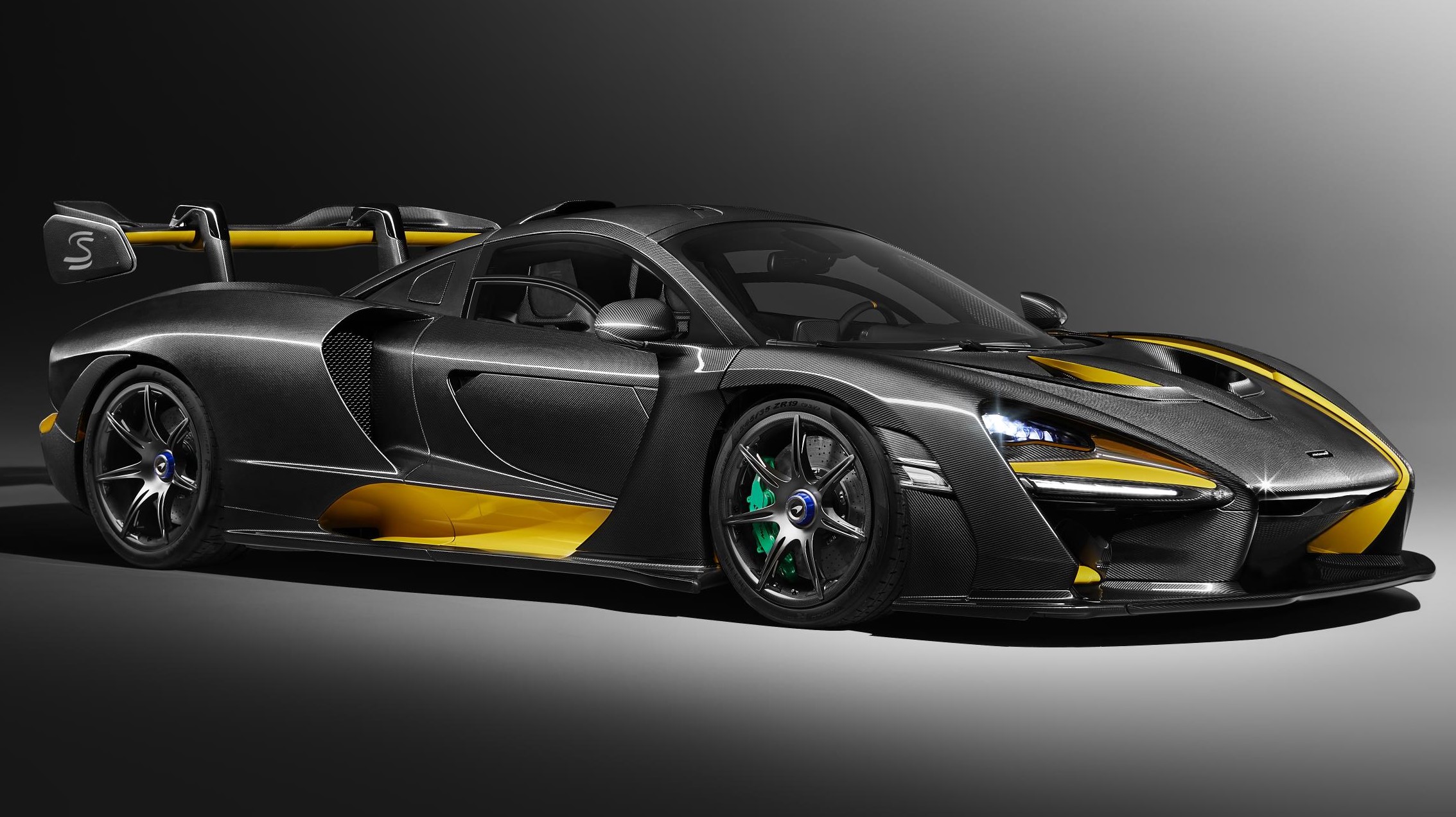
McLAREN SENNA WEAVES ITS MAGIC IN GENEVA WITH VISUAL CARBON FIBRE-BODIED ‘CARBON THEME’ FROM McLAREN SPECIAL OPERATIONS
- New ultimate McLaren road-legal track car makes its public debut next week at the 88th Geneva International Motor Show
- ‘Carbon Theme’ bespoke project by McLaren Special Operations (MSO) combines gloss Visual Carbon Fibre body with Carbon Black Alcantara ® interior trim to striking effect
- Solar Yellow and Laurel Green detailing echoes the helmet livery of Ayrton Senna, legendary Brazilian Formula 1 driver and three-time World Champion at the wheel of a McLaren
- New ultra-lightweight MSO 7-Spoke Hybrid Carbon Fibre Wheels will be available to order soon as a retailer-fit option
- McLaren Automotive press conference at 10:45 CET on Tuesday March 6 in Geneva promises an additional surprise
The new McLaren Senna is set to raise heartrates at the 88th Geneva Motor Show as it bares all to appear in Visual Carbon Fibre. The McLaren Senna Carbon Theme by McLaren Special Operations (MSO) is one of five themes* developed by MSO for a car that has been the centre of attention since the first images were released in December.
The Visual Carbon Fibre exterior is the most obvious individual feature of the McLaren Senna Carbon Theme by MSO. Comprising 67 parts, the full body set takes almost 1,000 hours to produce. Solar Yellow detailing on the sill exteriors, rear wing and front active aero blades – a process that accounted for almost 250 hours of MSO time – combines with Laurel Green brake calipers in recognition of the helmet colours of the legendary Brazilian Formula 1 racing driver.
The colours are carried through to the interior of the car, with the door gas strut in Laurel Green and the contrast stitching on the Carbon Black Alcantara® trim on seats, door inners and facia. The steering wheel also has a leather centre band in a similar yellow hue.
Both seats feature a Senna ‘S’ on the headrest and the same detail is repeated in satin finish Visual Carbon Fibre on the end plates of the rear wing, a result achieved using a highly specialised process that sees each matt-finished logo embedded into the gloss carbon fibre panel. One of the front fenders proudly displays the Senna brand.
“The McLaren Senna customers in the process of specifying their own, personalised cars are almost without exception commissioning an elevated level of MSO content, so we are definitely appealing to our target audience,” explained Ansar Ali, Managing Director, McLaren Special Operations. “With the car having generated so much interest since its unveiling in December, we knew we needed to produce something very special in order to showcase the unique talents of McLaren Special Operations; the McLaren Senna Carbon Theme by MSO at the Geneva Motor Show is exactly the kind of project we thrive on delivering and once customers have had the opportunity to view it in person, I would not be at all surprised to see a rise in expressions of interest for MSO Visual Carbon Fibre cars similar to this one.”
McLaren Special Operations is also taking the opportunity to introduce a new McLaren Senna wheel option in Geneva. The standard wheel is available in three finishes, but the new MSO 7-Spoke, Hybrid Carbon Fibre Wheel is the only alternative design available from McLaren for the car. The centre-lock wheel is a forged aluminium/carbon fibre rim component that at 7.5kg (front wheel) without a tyre fitted, is up to 10 per cent lighter than the standard-fit wheel.
Benefitting dynamic performance by reducing unsprung weight, the carbon fibre hybrid wheels offer a 10-15 per cent reduction in rotating inertia, improving acceleration, braking and steering responses.
The MSO 7-Spoke Hybrid Carbon Fibre Wheel, which also offers McLaren Senna customers a further opportunity to personalise their purchase, is a retailer-fit only option that will be available to order soon in either Diamond Cut or Stealth finish. The Memphis Red and Vega Blue satin finish centre lock wheel nuts fitted to respectively the left- and right-hand sides of the McLaren Senna Carbon Theme car are available now to MSO Bespoke order.
Legalised for road use, but not sanitised to suit it, the new McLaren Senna was designed and developed from the outset to excel on a circuit and as a result has an uncompromised performance focus that is reflected in its appearance. The aggressive looks are the strongest expression yet of McLaren’s ‘form follows function’ philosophy and McLaren Special Operations is already seeing significant interest from McLaren Senna buyers wanting to make their cars even more distinctive.
Just 500 examples of the McLaren Senna will be produced and all are already assigned. Each vehicle is priced at £750,000 and will be hand-assembled by specialists at the McLaren Production Centre in Woking, Surrey, England, in a process taking close to 300 hours. Cars commissioned from McLaren Special Operations will take considerably longer to build and carry a financial premium; the bespoke personalisation carried out on the McLaren Senna Carbon Theme by MSO, for example, adds a little under £300,000 to the price.
McLaren Automotive will hold a press conference at the Geneva International Motor Show at 10:45 CET on Tuesday March 6, introducing the McLaren Senna and detailing corporate developments and a surprise announcement…
The Senna brand is a registered trademark of Ayrton Senna Empreendimentos Ltda.
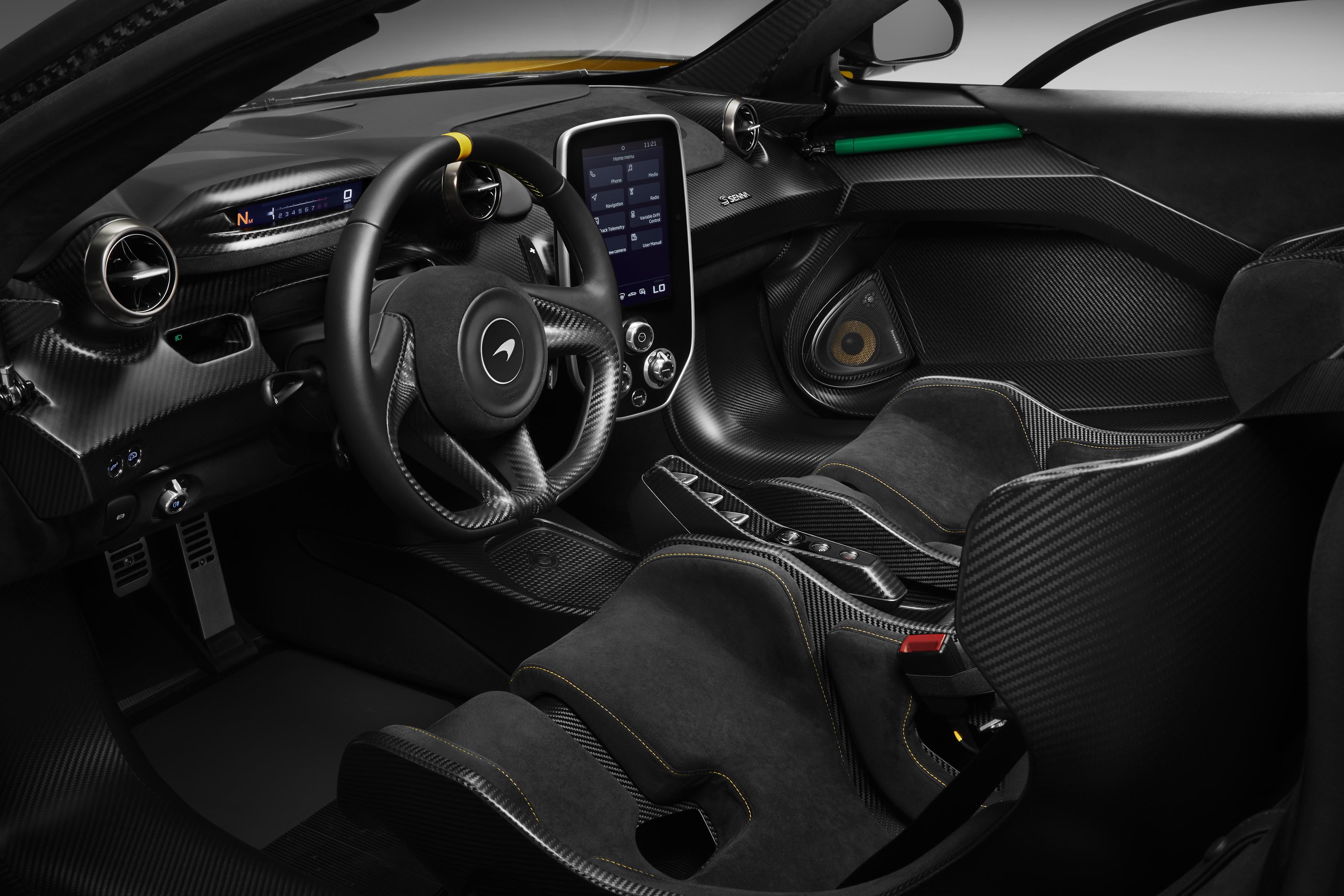

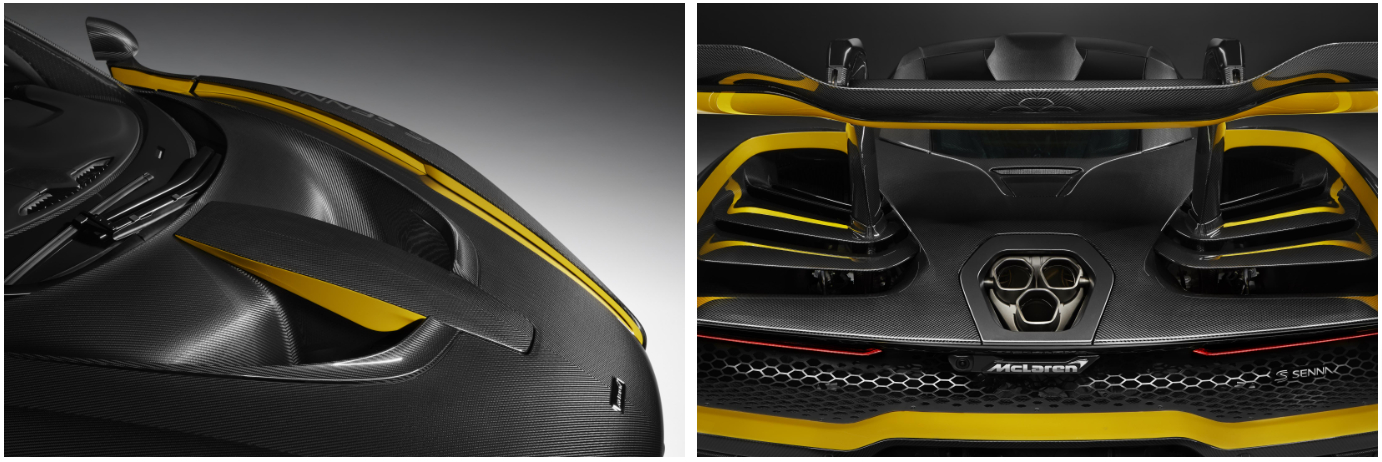
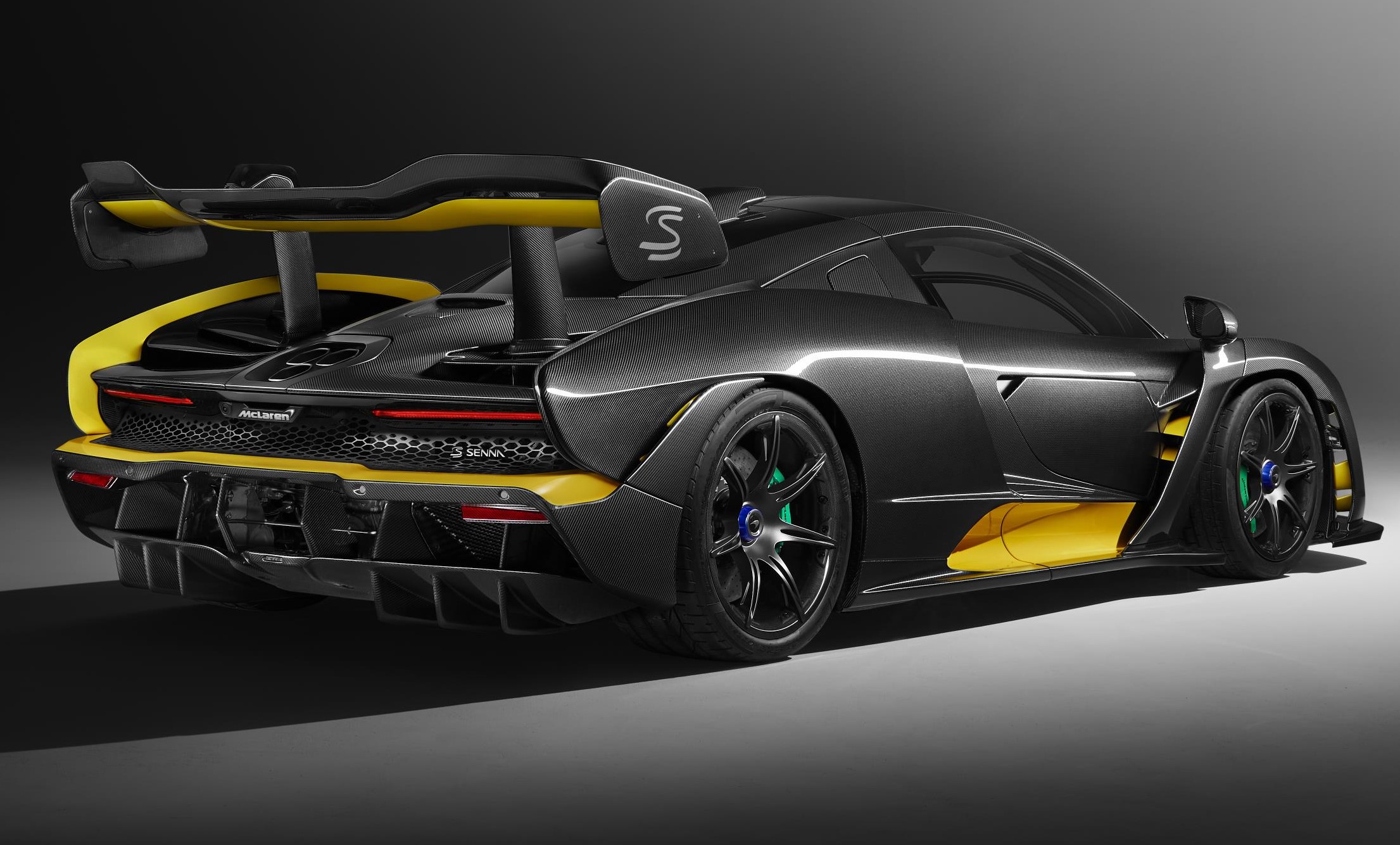
McLaren Senna Carbon Theme by McLaren Special Operations
Technical specification
| Body construction | Carbon fibre Monocage III central structure; aluminium front and rear frames; carbon fibre body panels |
| Drivetrain configuration | Longitudinal mid-engined; rear-wheel-drive |
| Active aerodynamic features | Active front aero blades; active rear wing |
| Maximum downforce generated | 800kg at 250 km/h (155mph) |
| Engine configuration | M840TR engine, 4.0-litre twin-turbo V8, 3,994cc |
| Engine power PS (bhp/kW) | 800 (789/597) @ 7,250 rpm |
| Engine torque Nm (lbs ft) | 800 (590) @ 5,500 – 6,700 rpm |
| Transmission | 7 Speed SSG (Seamless Shift Gearbox) |
| Powertrain modes | Comfort; Sport; Track |
| Suspension | McLaren RaceActive Chassis Control II (RCC II) system. Double wishbones front and rear; independent interconnected hydraulic dampers; K dampers |
| Suspension modes | Comfort; Sport; Track; Race |
| Steering | Electro-hydraulic, power-assisted |
| Brakes | Carbon ceramic discs with machined cooling vanes (390mm x 34mm front and rear). Aluminium monobloc six-piston front brake calipers; aluminium four-piston rear |
| Wheel size (inches) | Front: 19 x 8J; Rear: 20 x 10J |
| Tyres | Bespoke Pirelli P ZERO™ Trofeo R
Front: 245/35/R19; Rear: 315/30/R20 |
| Lightest dry weight, kg (lbs) | 1,198 (2,641) |
| Power to weight ratio, lightest dry weight | 668 PS per tonne |
Exterior
| Exterior Body Finish | Bespoke Finish: Gloss Visual Carbon Fibre |
| Exterior Accent Colour | Bespoke Accent: Solar Yellow Detailing |
| Exhaust Heatshield Finish | Gloss Black |
| Exterior Door Upper | Gloss Visual Carbon Fibre |
| Exterior Door Lower | Gloss Visual Carbon Fibre |
Wheels and brakes
| Wheels | MSO 7-Spoke, Hybrid Carbon Fibre Wheel in Stealth finish |
| Centre Lock Wheel Nuts | Bespoke Colour: Memphis Red & Vega Blue in Satin finish |
| Brake caliper finish | Bespoke colour: Laurel Green |
Interior
| Trim | Bespoke Interior: Carbon Black Alcantara® with yellow contrast stitch; steering wheel 12 o’clock mark in yellow leather; Laurel Green door gas strut |
| Bulkhead | Glazed |
| Sill Trim | MSO Defined Carbon Fibre Extended Sill Finishers |
| Steering Wheel | Jet Black Leather |
| Seat Type/Size | Super-Lightweight Racing Seat/Regular |
Infotainment
| Displays | 8-inch high resolution touch screen and folding driver display |
| Infotainment | McLaren Infotainment System (MIS) |
| Audio System | Bowers & Wilkins 7-speaker audio system |
| Track Telemetry | McLaren Track Telemetry & 3 Cameras |
| Connectivity | Bluetooth telephony and audio streaming, USB Connectivity and Aux in |
Driver assistance
| Driver Assistance | Cruise control with speed limit function; Variable Drift Control; Brake Assist with Brake Disc Wipe and Hill Hold Assist; Anti-Lock Braking System (ABS); Traction Control System (TCS); Electronic Stability Control (ESC) with Dynamic Mode |
| Parking | 2 Front & 4 Rear Parking Sensors with Reversing Camera |
Performance data*
| 0-60mph | 2.7 seconds |
| 0-100 km/h (0-62mph) | 2.8 seconds |
| 0-200 km/h (0-124mph) | 6.8 seconds |
| 0-300 km/h (0-186mph) | 17.5 seconds |
| 0-400 m / ¼ mile | 9.9 seconds |
| Maximum Speed | 340 km/h (211 mph) |
| Braking 300–0 km/h (186-0 mph) | 215 metres |
| Braking 200–0 km/h (124–0 mph) | 100 metres |
| Braking 100–0 km/h (62–0 mph) | 29.5 metres |
*All figures stated are McLaren engineering figures and subject to final verification
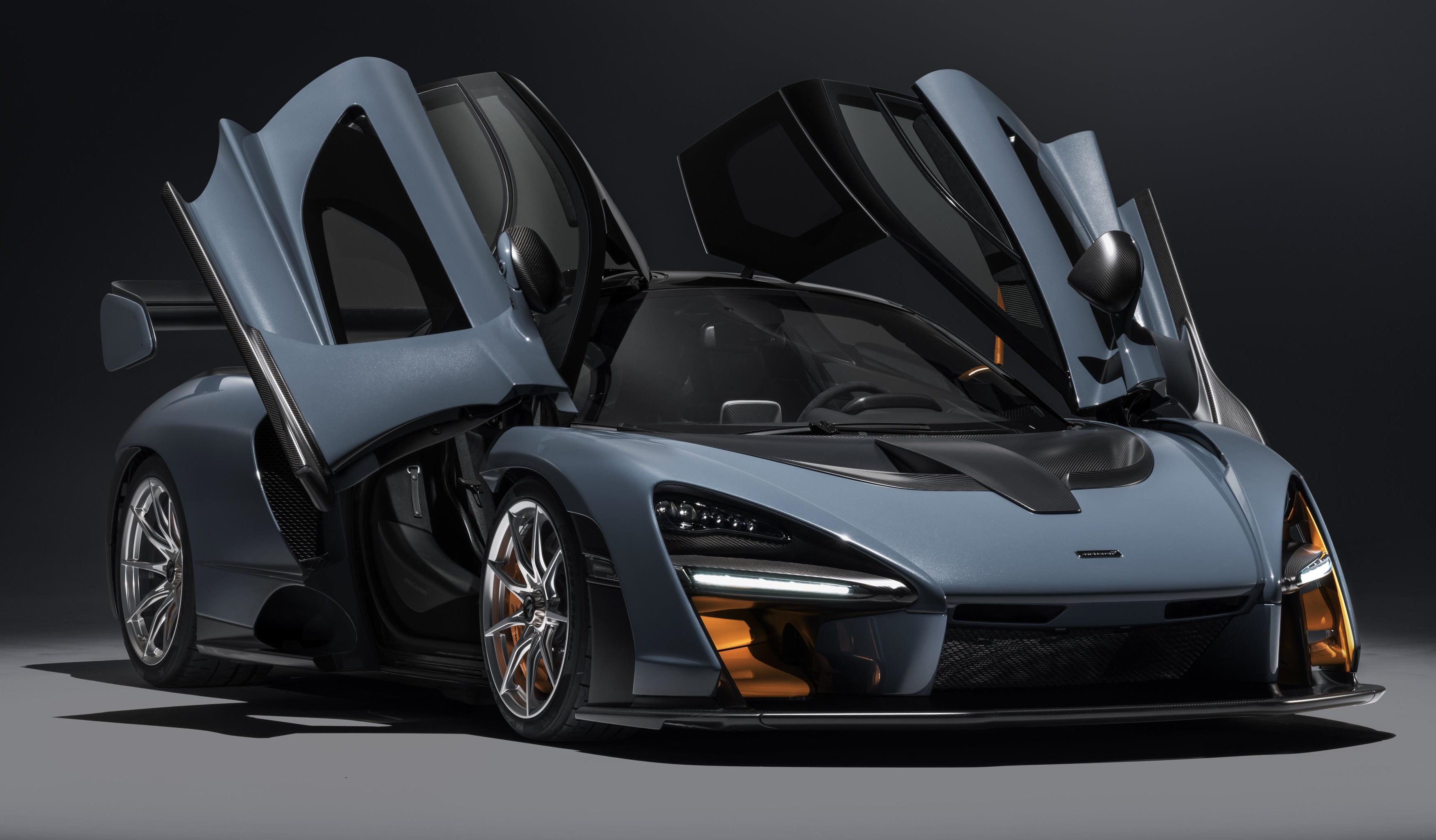
NEW FACTS, FIGURES AND A SHADE OF GREY REVEALED FOR MCLAREN SENNA AHEAD OF GENEVA MOTOR SHOW
- McLaren Senna will make its public debut on March 6, 2018 at the 88th Geneva International Motor Show
- Body design, active aero front and rear and rear wing key to generating 1,763.7lbs of downforce at 155mph
- Acceleration from 0-124mph in 6.8 seconds; 0-62mph in 2.8 seconds; maximum speed of 211mph
- Carbon fiber Monocage III chassis and carbon fiber body panels integral to the McLaren Senna being the lightest road car McLaren has built since the iconic F1, at 2,641lbs* giving a power-to-weight ratio of 659bhp per ton
- Production limited to 500 units, all hand-assembled at the McLaren Production Centre in Woking, Surrey, England in a 300-hour process – and all already allocated
- McLaren Senna Technical Specification (pdf)
“You commit yourself to such a level where there is no compromise. You give everything you have; everything, absolutely everything.” Ayrton Senna, three-times Formula 1 World Champion in a McLaren
Eagerly awaited technical information and new images of the McLaren Senna are today released ahead of the car’s public debut on Tuesday, March 6 at the 88th Geneva International Motor Show.
True to the legendary abilities of the racing driver whose name it bears, the McLaren Senna has been designed, engineered and developed to be the ultimate road-legal McLaren track car. With 789bhp and 590b ft from its 4.0-litre, twin-turbocharged V8 – McLaren’ s most powerful-ever internal combustion engine in a road car – and the ability to generate a staggering 1,763.7lbs of downforce, the 2,641lbs* McLaren Senna delivers the purest possible connection between driver and car.
Performance is breathtaking. The McLaren Senna can cover 0–62mph in 2.8 seconds; 0-124 mph is achieved in just 6.8 seconds and a standing quarter-mile (402m) in only 9.9 seconds. Impressive though the straight-line acceleration and maximum speed of 211 mph are, the true depth of the performance credentials of the new Ultimate Series McLaren will be revealed when it calls on downforce of up to 1,763.7lbs on a circuit, against the stop-watch.
“The McLaren Senna is a car like no other: the personification of McLaren’s motorsport DNA, legalized for road use but designed and developed from the outset to excel on a circuit. Every element of this new Ultimate Series McLaren has an uncompromised performance focus, honed to ensure the purest possible connection between driver and machine and deliver the ultimate track driving experience in the way that only a McLaren can.”
Mike Flewitt, Chief Executive Officer, McLaren Automotive
The McLaren Senna combines low vehicle weight, extreme power, aerodynamic excellence and a revolutionary, active suspension system to deliver the most responsive and engaging road car experience to date from the British luxury sportscar and supercar maker.
The McLaren Senna is priced at $958,966 (U.S).** Just 500 will be built, each hand-assembled in a 300-hour process at the McLaren Production Centre in Woking, Surrey, England. All are assigned to buyers; the one remaining build allocation having been auctioned in December 2017 at a private event for McLaren customers. The winning bid was £2 million, with the proceeds going to the Ayrton Senna Institute, a non-profit organization dedicated to providing education for nearly two million unprivileged children and youngsters in Brazil.
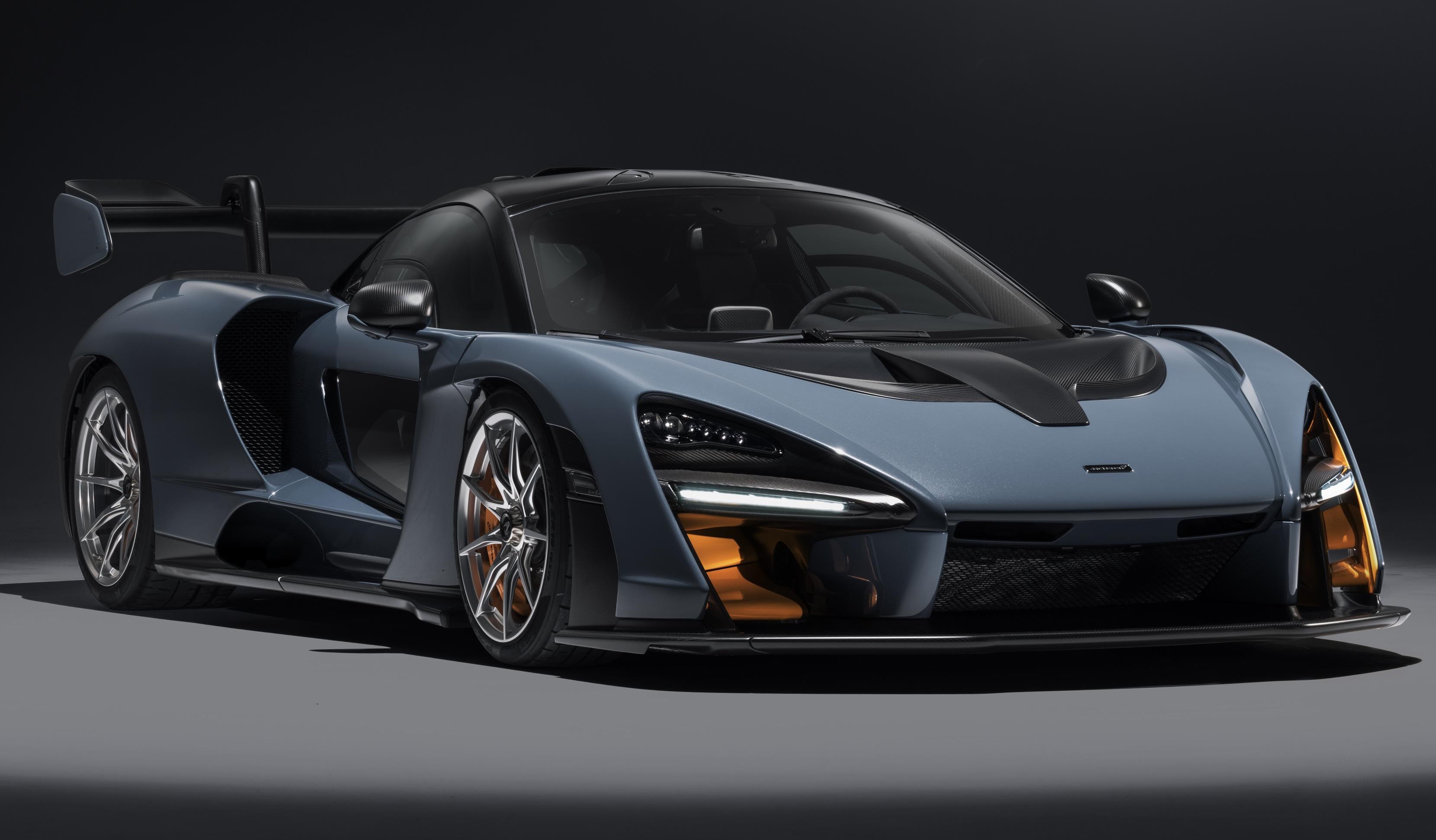
Aerodynamic design
The visual impact of the car is the equal of its savage performance. Organic shapes have given way to an aggressive design language that is ruthless in bending and guiding airflow to meet aerodynamic requirements and the strongest expression yet of McLaren’s ‘form follows function’ philosophy. Proportionally, it is unmistakably a McLaren, but you cannot follow a single body line from front to rear without it passing through a functional intake or vent.
“The design language of the McLaren Senna is extremely aggressive and different from any previous McLaren – because no other road-legal McLaren has had to fulfil such an uncompromising brief,” explained Rob Melville, Design Director, McLaren Automotive.” When you see the car for the first time, you know instantly how single-minded and focused it is; to meet the performance targets we have had to go to an entirely different level from even the McLaren P1™.”
Precise control of airflow begins the moment it hits the nose of the car, the air meeting four surfaces – front splitter; active aero blades: secondary fixed aero blades and slot-gaps located between the headlights and daytime running lights – and being turned by each element in sequence. The design of the rear of the car was born entirely from aerodynamic and cooling requirements, prominent ‘gurney flaps’ ahead of a succession of stepped louvres directing air away from the rear deck and down the sides of the body. The resulting area of low pressure draws hot air out from the high-temperature radiators and engine bay, the louvres ensuring that airflow does not impact rear wing efficiency. Unique slash-cut exhausts make a similar airflow contribution, their positioning and angle negating anydisturbance to the wing or rear diffuser.
The exhaust pipes exit through the lowest rear deck (measured at the trailing edge) of any McLaren road car, a full 7.09in lower than the McLaren Super Series. In contrast to the ultra-low rear deck, the hydraulically-operated, double-element carbon fiber rear wing – a major contributor to the downforce generated – is noticeably high and constantly adjusts to optimize downforce and maintain ideal aerodynamic balance. The wing weighs just 10.75lbs, yet can support more than 100 times its own weight in downforce.
The double diffuser at the rear is equally prominent; crafted from a single piece of carbon fiber, it starts under the rear axle and as it increases in height accelerates air out from under the vehicle. This creates a low-pressure zone and ‘sucks’ the McLaren Senna to the ground.
Carbon fiber construction
McLaren pioneered carbon fiber technology in Formula 1 and the Monocage III carbon structure at the center of the McLaren Senna can trace its lineage back to 1981 and the McLaren MP4/1, the first carbon Formula 1™ racing car. Monocage III is the strongest carbon fiber monocoque ever created by McLaren for a road car and features an innovative double-walled rear assembly that provides an in-built protective roll cage. Monocage III is optimized to create the lightest structure possible and is one of the reasons why, at 2,641lbs*, the McLaren Senna is the lightest road car McLaren has built since the F1.
The benefits of carbon fiber are felt throughout the McLaren Senna. The body panels, which have the immense structural rigidity needed to support the aerodynamic forces they are subjected to at high speeds on a race track, are incredibly strong and lightweight. In total, the carbon fiber body panels of the McLaren Senna weigh less than 132.28lbs.
Carbon fiber and Alcantara® are used extensively throughout the interior, reflecting the stripped-back, functional nature of the McLaren Senna. The dashboard, doors and visible elements of the Monocage III are all in exposed carbon fiber. Alcantara® (or leather if preferred) covers the side airbags and the lack of further interior trim saves weight and reveals the construction of the dihedral doors. Even the door gas struts, which can be color-matched to the brake calipers and front active aero blades, are exposed to save vital grams.
The inherent strength of Monocage III allows for remarkably slim roof pillars that ensure excellent views through the deep, wide windscreen and across the front fenders. This makes it easier to perfectly place the McLaren Senna through corners, as well as improving visibility in general. Opting for glazed upper and lower door sections in place of the standard carbon fiber panels allows even more light to flood into the cockpit.


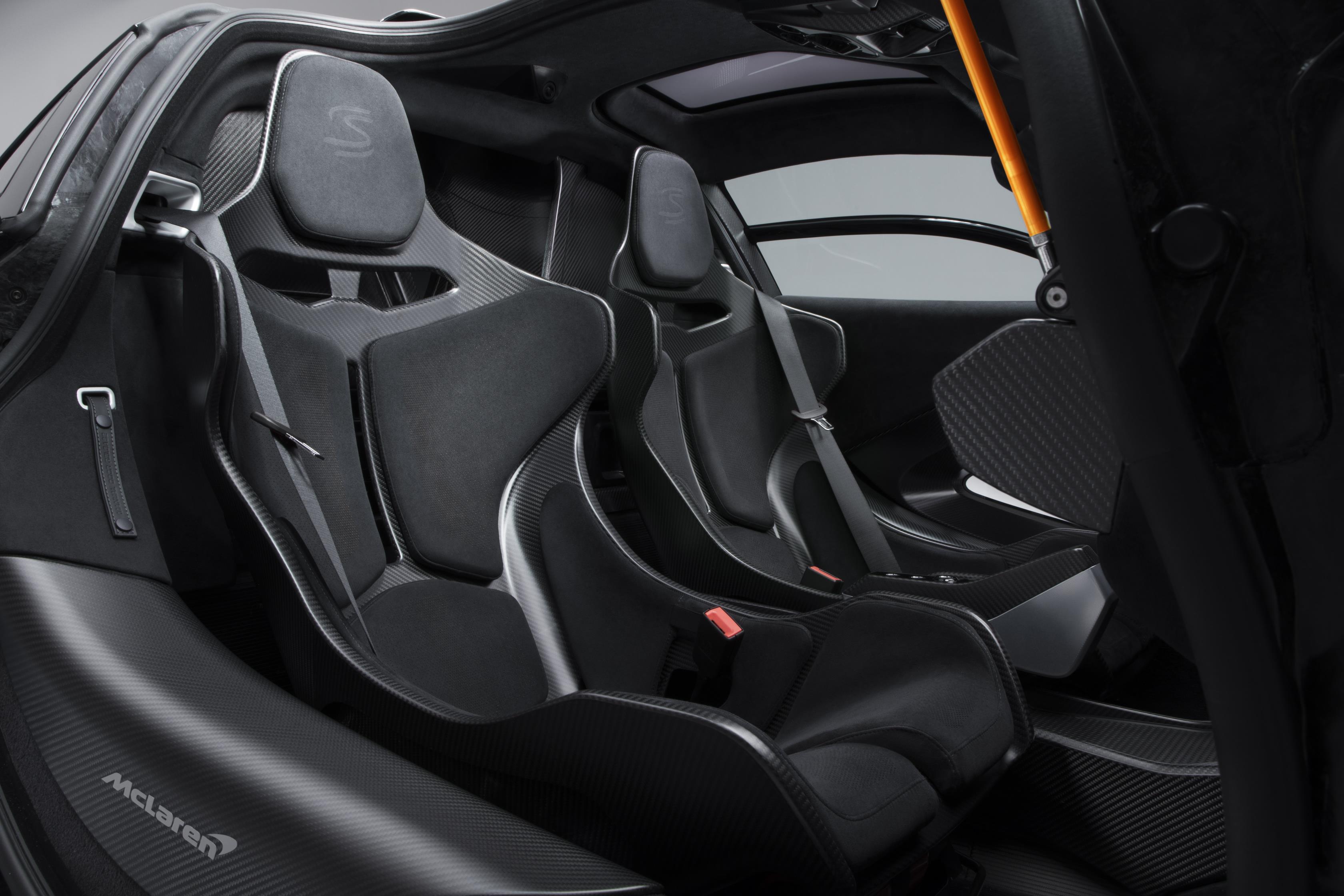
Cockpit environment
The driver’s seat moves on rails and the foot pedals are fixed – the optimum solution to reduce component complexity and weight. The module to select Drive, Neutral and Reverse is fixed to the driver’s seat and moves with it, ensuring the controls are always close at hand. Door release mechanisms and window switches have been moved to the center of the vehicle in a roof-mounted panel.
The three-spoke steering wheel, trimmed in Alcantara® or leather, is free of buttons and switches to allow a pure focus on the sensory feedback it delivers. The grip offered with and without gloves has been optimized for track driving, as has the design of the wheel itself. Tactile, extended gear shift paddles in satin-finish visual carbon fiber, linked with a rocker switch, are fixed behind the steering wheel.
The driver receives information from the McLaren Folding Driver Display and the central infotainment screen. In Full Display Mode, the folding driver display presents information on an upright TFT screen, with three different layouts depending on whether the McLaren Senna is being driven in Comfort, Sport, Track or Race modes. Linked to the Active Dynamics Panel settings or independently controlled if preferred, the display screen slides down into Slim Display Mode to show only crucial information such as speed, engine rpm and selected gear. This position is designed for circuit driving, where it further improves forward visibility of the track, but will also appeal to those who prefer a simpler display while driving on road.
The ‘floating’ central infotainment screen is presented in portrait to increase interior space. It is also angled out and up towards the driver to be easily visible within line of sight even when a helmet is being worn. The edge-to-edge glass screen integrates the Active Dynamics Panel and an 8-inch display that presents vehicle functions to the driver: audio, media, navigation and other features are all controlled using this TFT screen.
A range of luxury and convenience features are available upon request, including high-grade leathers and a wider ‘Touring’ specification of the Super-Lightweight carbon fiber seat. Parking sensors and a rear-view camera are no-cost options. Additionally, McLaren has collaborated with Bowers & Wilkins to create an audio system specifically designed for the McLaren Senna, the optional, ultra-lightweight 7-speaker audio system weighing just 16.14lbs.
M840TR engine and transmission
The twin-turbocharged V8 engine, which is coded M840TR, features a flat-plane crankshaft, race-inspired dry sump lubrication and lightweight connecting rods and pistons that reduce mass in the powertrain. Ultra-low inertia twin-scroll turbochargers and electronically-controlled wastegates give an immediate sense of retardation, enhancing engine responsiveness. Lightweight camshafts and pistons unique to the McLaren Senna and externally repositioned dump valves are among other Senna-specific components. Additionally, ion sensing with individual sensors per cylinder enables higher pressures and temperatures than on other McLaren engines.
Extensive dyno work has perfected control strategies that deliver the power and torque the McLaren Senna demands. The engine produces 516lb ft from just 3,000rpm, with peak torque of 590lb ft available from 5,500-6,700rpm. 789bhp peak power comes at 7,250rpm.
The unique Inconel and titanium exhaust is another key element of the high-performance powertrain. Tightly packaged and engineered to reduce weight, the exhaust uses either a twin-exit or triple-exit active system depending on market requirements. The sound from the exhaust is loud and sharp, singing like a motorcycle race engine in its ferocity and quite different to other McLarens. The intense crescendo encourages the driver to use high rpms, the volume increasing with 10dB for every 2,000rpm, climbing right through to the engine’s rev limit.
A dual-clutch, seamless-shift, seven-speed gearbox delivers power to the rear wheels. The default transmission mode is fully automatic, but a McLaren Senna driver can select full manual control of gear shifts via the Active Dynamics Panel located within the centrally-mounted screen and change gear using elongated, carbon fiber paddles mounted on a rocker behind the steering wheel. The paddles are optimized to be used both with or without racing gloves.
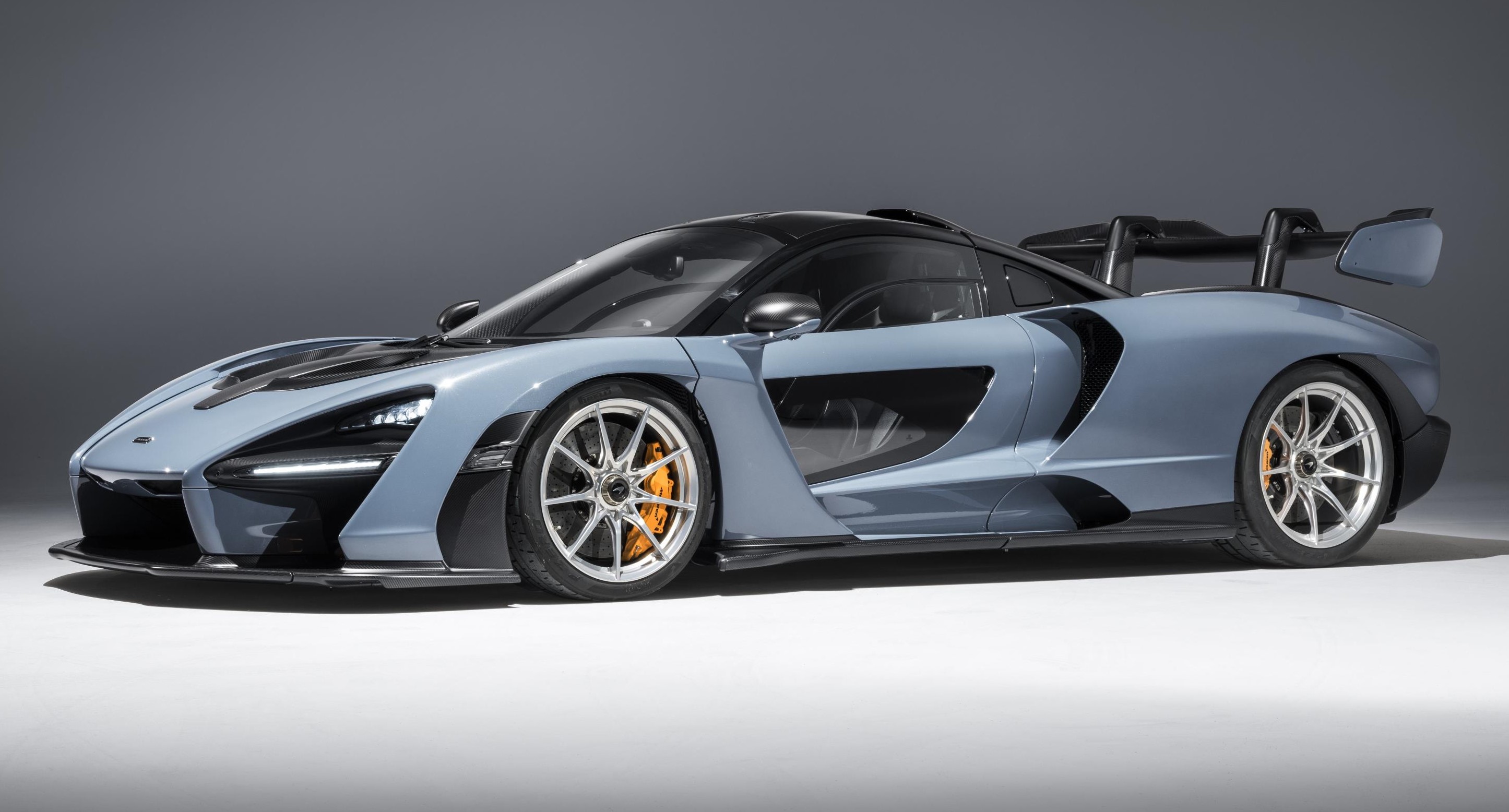
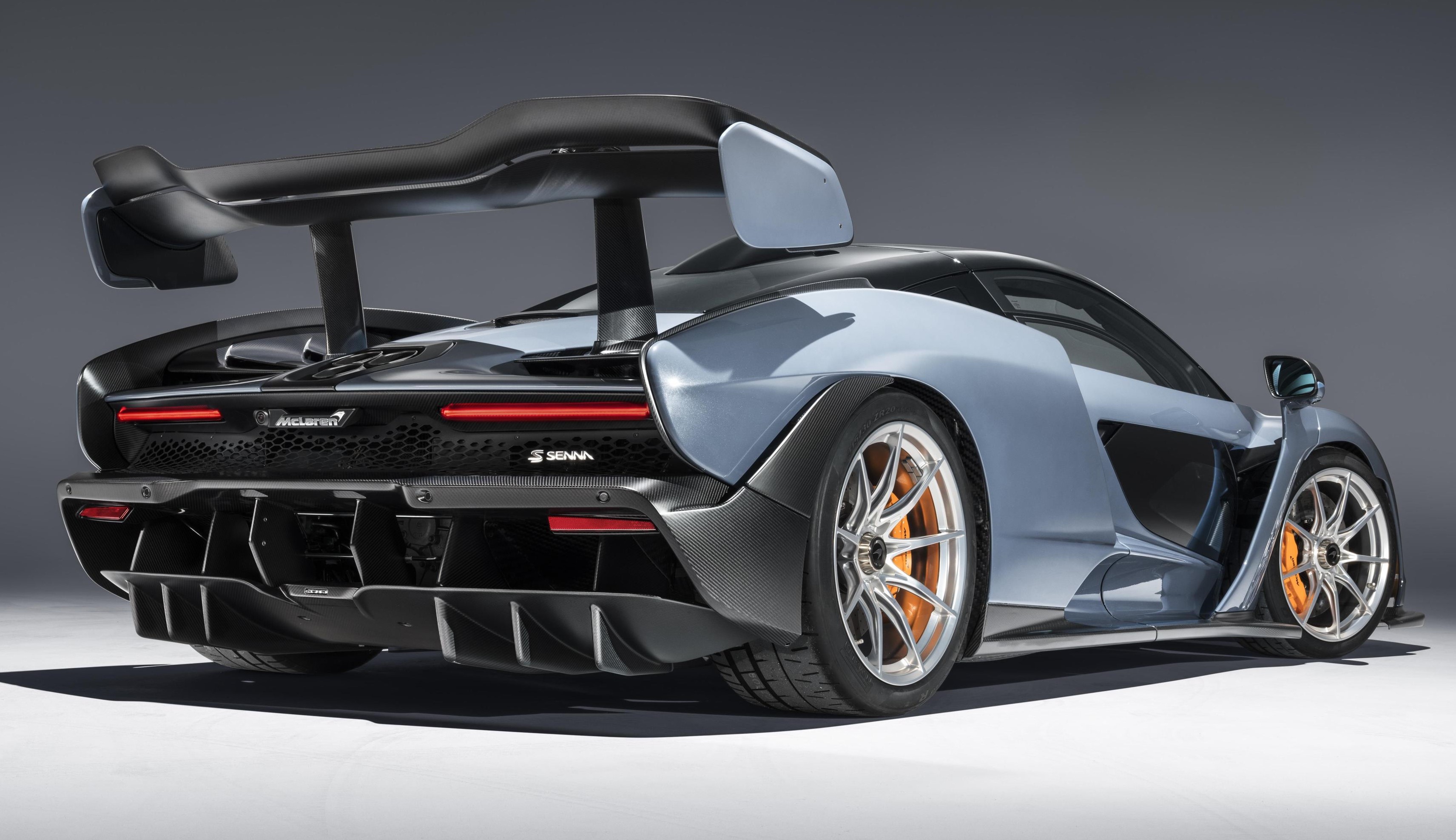
RaceActive Chassis Control II suspension; tires and brakes
McLaren Automotive has pioneered the use of adjustable suspension technology since the inception of the MP4 12C, with its ground-breaking ProActive Chassis Control system. The new, track-focused suspension that makes its debut in the McLaren Senna is the most advanced system ever in a McLaren road car. Called RaceActive Chassis Control II (RCC II), it features double wishbones front and rear, with adaptive dampers interconnected hydraulically, both left to right and front to back. Data from sensors – including four wheel accelerometers, two pressure sensors per damper and multiple body sensors – is analyzed and reacted to in a mere 2 milliseconds to ensure perfect damping response. The continuously variable system advances the control strategy introduced on the McLaren 720S to incorporate Race mode, which introduces significantly stiffer suspension, a lower ride height and a lower center of gravity.
“The McLaren Senna delivers real performance – accessible and attainable because of an intuitive connection, while at the same time rewarding, exciting and challenging to the very best drivers in the world,” comments Andy Palmer, Vehicle Line Director – Ultimate Series, McLaren Automotive. “The sensory experience of driving the car is also vitally important: through what a driver feels, hears and sees, we want every moment behind the wheel of a McLaren Senna to deliver the emotional intensity of a convertible and the pure connection of a race car.”
The top speed of the McLaren Senna is not limited in Race mode, but above 155mph the aero blades and rear wing are actively trimmed to preserve peak downforce levels, which would otherwise continue to increase with speed and impart excessive load on the suspension and tires. A driver can adjust handling parameters using the Active Dynamics Panel to access Comfort, Sport and Track modes; Race mode is selected via a button in the roof-mounted panel.
Due to its extreme performance, the McLaren Senna features bespoke tires developed in conjunction with McLaren technical partner, Pirelli. The Pirelli P ZERO™ Trofeo R tires (245/35 ZR19 at the front and 315/30 ZR20 at the rear) are designed for dry race tracks but are also approved for road use. The asymmetrical tread pattern provides outstanding lateral grip and the special construction maintains cornering stiffness. Specific development work was undertaken on the compound to shorten braking distances, improve longitudinal performance, create a consistent reaction between the front and rear axles and heighten on-center steering response.
The braking system is the most advanced ever fitted to a McLaren road car. Each CCM-R carbon ceramic brake disc brakes seven months to create and has cooling vanes machined into the disc, rather than molded. The Formula1 -inspired front calipers are a super-stiff monobloc design to maintain pedal feel and feature six ventilated pistons to reduce temperatures.
Tailored for individual choice
Five ‘By McLaren’ specifications have been created by McLaren designers as those that best showcase the McLaren Senna. Stealth Cosmos black, Trophy Kyanos blue, Trophy Mira orange, Vision Pure white and Vision Victory grey exterior paint is complemented in each specification by front aero blades, front fender inners, brake calipers, door gas struts and seat perforation in a contrasting color. A further 18 exterior paint colors can be specified at no additional cost, with 16 more paint options available from the MSO Defined palette offered by McLaren Special Operations. Beyond this, a virtually limitless spectrum of colors can be created through the MSO Bespoke service.
In addition to selecting the exterior color theme for their new McLaren Senna, customers can explore the different By McLaren Designer interior alternatives that complement the Jet-Black leather or Carbon Black Alcantara® and visual carbon fiber cockpit materials. Color-coded aero blades and fender inners; an exhaust heatshield in Gloss Black, Satin Raw Metal or Dark Stealth finish; a carbon fiber or Alcantara® steering wheel and three finishes to the Ultra-Lightweight 9-Spoke forged alloy wheels are among the specification choices available at no additional cost.
“The McLaren Senna honors my uncle because it is so utterly focused upon the driver, and their absolute connection with the vehicle. This engagement, these sensory cues that the driver responds to and relies upon, the whole immersive experience, has been at the heart of the development from the very start.”
Bruno Senna, racing driver, nephew of Ayrton Senna and McLaren ambassador
*Lightest dry weight
** U.S. base MSRP does not include federal/state/local taxes, license, titling, registration or transportation fees.
